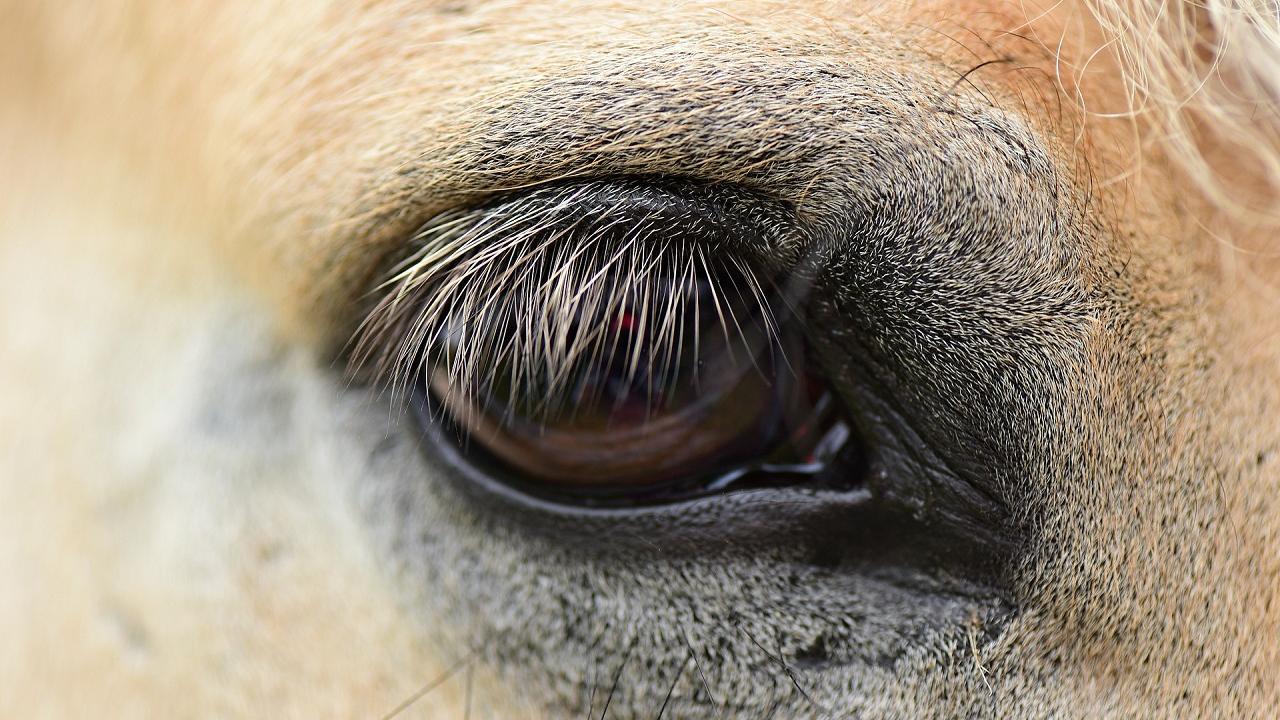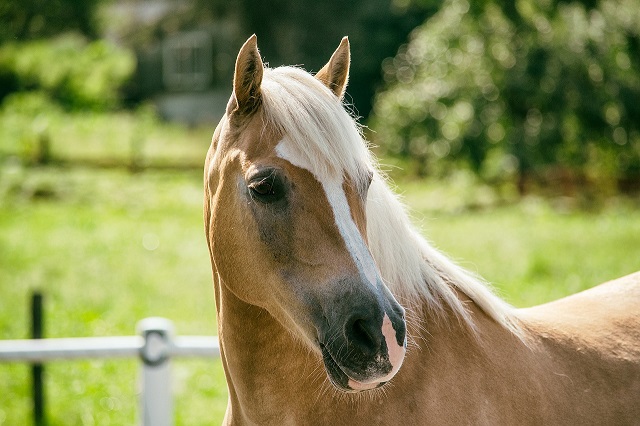
Ocular Squamous Cell Carcinoma
Takeaways
- Ocular squamous cell carcinoma (SCC) is the most common form of eye cancer in horses.
- UV light exposure is a predisposing factor for ocular SCC development.
- Ocular SCC can cause visual impairment or blindness and can be life threatening.
- Early detection of tumors may lead to a more successful outcome.
- A genetic risk factor for ocular SCC has been identified in breeds including Haflingers, Belgians, Rocky Mountain Horses, Holsteiners, Belgian Warmbloods, and Connemara Ponies.
- A DNA test is available to identify at-risk horses from these breeds and can help to inform breeding and clinical management decisions.
What is ocular squamous cell carcinoma?
Ocular squamous cell carcinoma (SCC) is the most common form of cancer to affect the eyes and eyelids of horses, and the second most common cause of cancer in horses overall (after equine sarcoid). The tumor arises in the outermost layer of skin, conjunctival, or corneal cells, with UV light (sunlight) exposure being a known risk factor. Horses that lack pigment in the skin surrounding their eyes (have white or pink eyelids) are at greater risk of developing SCC on their eyelids than horses with pigment around their eyes. Additionally, horses with a chestnut-based coat color appear to be at higher risk.
Tumors may grow rapidly and can spread to invade adjacent tissues, causing visual impairment and destruction of the eye. Lesions typically occur in one eye, though both eyes can be affected. In a small number of cases, tumors spread to other organs such as the brain by growing behind the eye and along the optic nerve, or to the lungs through metastasis. Certain breeds, including Haflingers and Belgians, have a genetic predisposition to ocular SCC development, and a genetic risk factor has been identified. This risk factor also explains the only reported case in the Rocky Mountain Horse breed, two Connemara Pony horses with ocular SCC, and a Warmblood cross with cancer on the right eye. Further research has identified the causative variant at low levels in Holsteiners and Belgian Warmbloods, indicating that further evaluation in additional breeds is warranted.
What are the clinical signs of ocular squamous cell carcinoma?
Ocular SCC can occur in numerous different locations around the horse’s eye, including the cornea (clear part at the front of the eye), the conjunctiva (thin pink tissue covering the white part of the eye), limbus (where the cornea meets the sclera), the eyelids, and the third eyelid (also called the nictitating membrane). Lesions are often raised, have a rough appearance, and are pink in color when they arise from the cornea, conjunctiva, limbus, or third eyelid. Thick yellow ocular discharge may be observed. When the upper and lower eyelids are affected, clinical signs of ocular SCC often begin as small, red areas that may look like burns, bleed intermittently, and form scabs.
How is ocular squamous cell carcinoma diagnosed?
A veterinarian may suspect ocular SCC if a horse has a raised, pink mass or ulcerated lesions around the eye. However, other conditions, such as summer sores (cutaneous habronemiasis), can look like SCC. Therefore, histologic analysis of a biopsy from the affected area is required to confirm a diagnosis of ocular SCC.
How is ocular squamous cell carcinoma treated?
Treatment options are determined by the size and location of the tumor(s). Smaller lesions are generally easier to treat. Unfortunately, many tumors are large by the time they are noticed, especially if they are located on the third eyelid, which can be difficult to see. The longer the tumor is present, the more likely it will invade surrounding tissues, and the more difficult it becomes to treat. Surgery can be performed to remove the tumor, but recurrence rates have been reported to be as high as 83.3% in the absence of adjunctive therapy (treatment in addition to surgical removal of the tumor). Adjunctive therapy options include chemotherapy (creams and injectables), radiation therapy, photodynamic therapy, and cryotherapy (freezing). In some cases, ocular SCC can be treated in the field, though horses with large tumors should undergo an advanced diagnostic imaging technique called computed tomography (CT) to determine the full extent of the tumor prior to surgery. Horses with large or invasive tumors may require removal of the affected eye.
What is the prognosis for ocular squamous cell carcinoma?
The prognosis for horses with ocular SCC depends on a variety of factors including the size and location of the tumor. If tumors are identified early, there is typically a good chance that a horse may be treated such that they do not need to have the eye removed. For horses with extensive tumors, it may be necessary to remove the eye in order to fully remove the tumor, and this can sometimes be a life-saving procedure. If a tumor is extensive enough that it has invaded the underlying bone, prognosis for life is poor.
How can ocular squamous cell carcinoma be prevented?

Researchers at UC Davis discovered a variant in the damage-specific DNA binding protein 2 gene (DDB2 for short) that has been identified as the causal risk factor for ocular SCC in several breeds. The function of this gene is to repair DNA that has been damaged by UV light. Horses with two copies of the variant (homozygous) are at increased risk of developing ocular SCC compared to horses with only one copy (heterozygous) or no copies of the variant. Approximately 80% of the cases in Haflinger and Belgian breeds were homozygous for this risk variant. Therefore, this risk factor does not explain all cases of ocular SCC and it is likely that additional genetic risk factors are contributing to cancer in these and other breeds.
Owners can use the DNA test available through the UC Davis Veterinary Genetics Laboratory to identify horses that are at higher risk for ocular SCC development and take precautions to protect them. It is advised that homozygous horses have routine eye exams performed so that tumors are caught early. Additionally, these high-risk horses should wear UV-protective fly masks and be stabled during peak sunlight hours. The test can also be used to help breeders of Haflingers, Belgians, Rocky Mountain Horses, Connemara Ponies, Holsteiners, and Belgian Warmbloods make informed decisions when selecting breeding pairs and avoid producing horses that are at risk of developing ocular SCC.
For more information:
UC Davis Veterinary Genetics Laboratory SCC test
Chen, L., Bellone, R.R., Wang, Y., Singer-Berk, M., Sugasawa, K., Ford, J.M., & Artandi, S.E. (2020). A novel DDB2 mutation causes defective recognition of UV-induced DNA damages and prevalent equine squamous cell carcinoma. DNA Repair, 97:103022.
Crausaz, M., Launois, T., Smith-Fleming, K., McCoy, A.M., Knickelbein, K.E., and R.R. Bellone. 2020. DDB2 Genetic Risk Factor for Ocular Squamous Cell Carcinoma Identified in Three Additional Horse Breeds. Genes 11(12):1460.
Singer-Berk, M.H., Knickelbein, K.E., Lounsberry, Z.T., Crausaz, M., Vig, S., Joshi, N., Britton, M., Settles, M.L., Reilly, C.M., Bentley, E., Nunnery, C., Dwyer, A., Lassaline, M.E., and R.R. Bellone. 2019. Additional Evidence for DDB2 T338M as a Genetic Risk Factor for Ocular Squamous Cell Carcinoma in Horses. International Journal of Genomics, vol. 2019, Article ID 3610965.
Knickelbein, K.E., Lassaline, M.E., Singer-Berk, M., Reilly, C.M., Clode, A.B., Famula, T.R., Michau, T.M., and R.R. Bellone. 2019. A missense mutation in damage-specific DNA binding protein 2 is a genetic risk factor for ocular squamous cell carcinoma in Belgian horses. Equine Vet J. 52(1):34-40.
Knickelbein KE, Lassaline ME, Bellone RR. 2019. Limbal squamous cell carcinoma in a Rocky Mountain Horse: Case report and investigation of genetic contribution. Veterinary Ophthalmology 22(2):201-5.
Singer‐Berk M, Knickelbein KE, Vig S, Liu J, Bentley E, Nunnery C, Reilly C, Dwyer A, Drögemüller C, Unger L, Gerber V, Lassaline M and Bellone RR. 2018. Genetic risk for squamous cell carcinoma of the nictitating membrane parallels that of the limbus in Haflinger horses. Anim Genet. 49: 457-460.
Bellone, R.R., Liu, J., Petersen, J.L., Mack, M., Singer-Berk, M., Drögemüller, C., Malvick, J., Wallner, B., Brem, G., Penedo, M.C., and M. Lassaline. 2017. A missense mutation in damage-specific DNA binding protein 2 is a genetic risk factor for limbus squamous cell carcinoma in horses. Int. J. Cancer 141:342-353.
